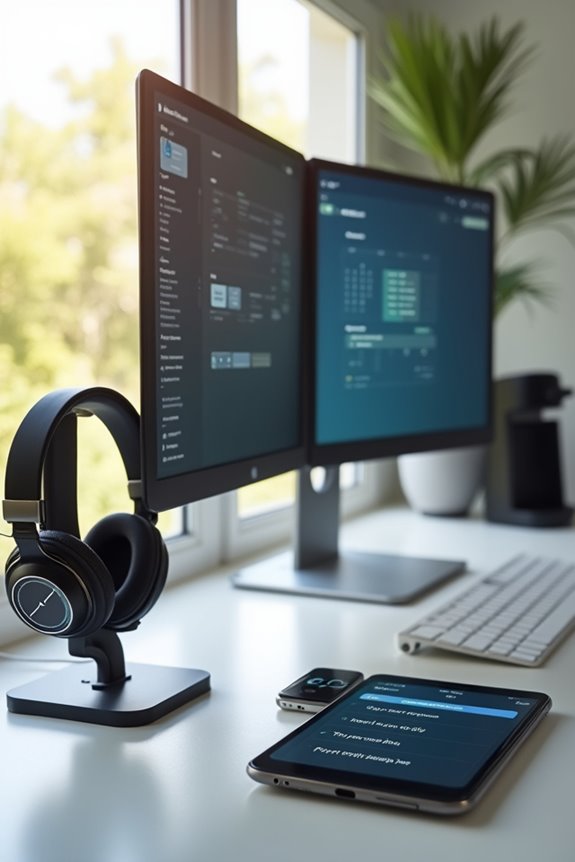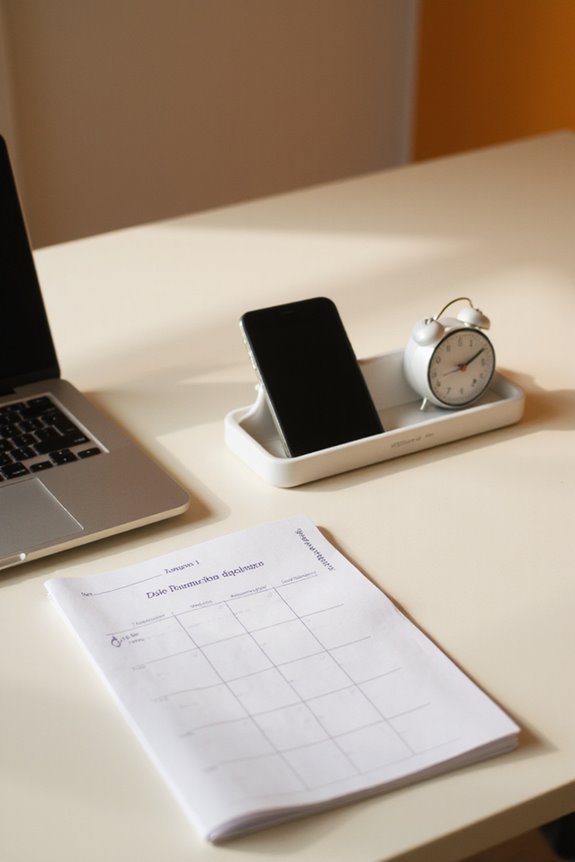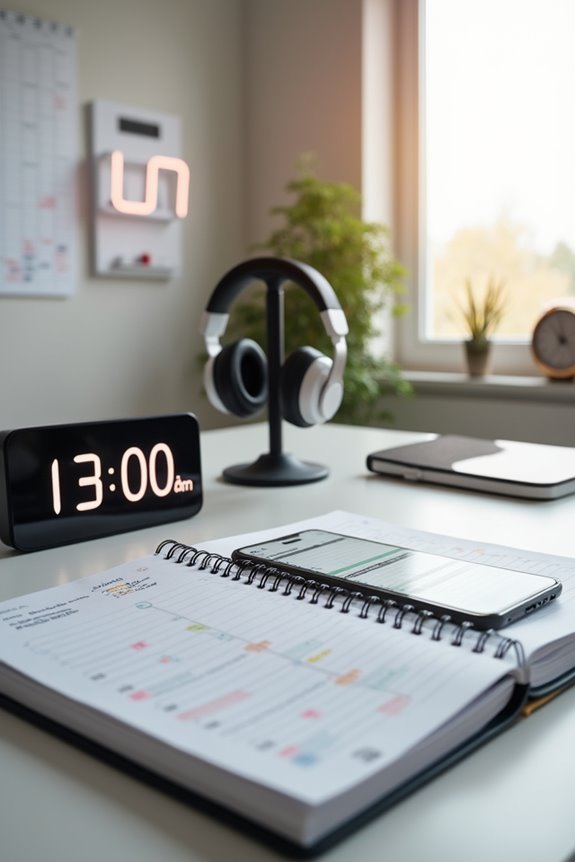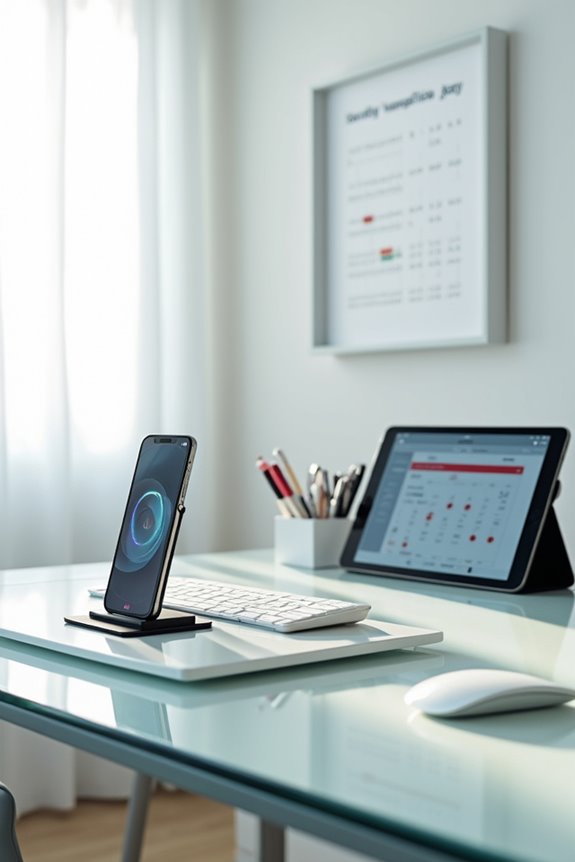Effective time management techniques for remote workers revolve around a few key strategies. First, establishing a structured routine helps enhance productivity. Next, leveraging technology, like project management tools and automation, can streamline tasks. It’s essential to set boundaries to maintain work-life balance, ensuring you define work hours and a dedicated workspace. Finally, overcoming distractions through focused environments and regular breaks can maximize your effectiveness. Continue exploring these techniques for deeper insights and practical applications.
Key Takeaways
- Implement time blocking to allocate specific periods for tasks, enhancing focus and productivity throughout the workday.
- Utilize project management software like Trello or Asana to organize tasks and track progress effectively.
- Set clear work hours and communication boundaries to maintain a healthy work-life balance and prevent burnout.
- Create a dedicated workspace to minimize distractions and reinforce the distinction between work and personal life.
- Regularly assess and prioritize tasks based on importance and deadlines to stay organized and resilient in remote work.
Establishing a Structured Routine
When working remotely, it’s essential to establish a structured routine that promotes productivity while ensuring a clear boundary between work and personal life. To do this effectively, I rely on time blocking, which allows me to allocate specific periods for tasks. This focused approach helps me avoid multitasking and increases my efficiency.
In addition, I prioritize break management by scheduling regular short breaks. These pauses are crucial for maintaining energy levels and improving concentration during work sessions. By setting clear work hours and creating a dedicated workspace, I reinforce the separation between my professional and personal life. Ultimately, this structured routine not only enhances productivity but also supports my overall well-being while working remotely.
Leveraging Technology for Efficiency

A structured routine sets the foundation for productivity, but it’s technology that can truly enhance that efficiency in a remote work environment. By leveraging automation tools like Zapier and IFTTT, I can automate repetitive tasks, freeing up valuable time for more important work.
Additionally, effective communication is essential; platforms such as Slack and Microsoft Teams help me stay connected with my team, ensuring seamless collaboration. I also utilize project management software like Trello or Asana to organize tasks, making it easier to track progress and meet deadlines.
Finally, time tracking tools such as Toggl help me monitor my productivity, allowing me to adjust my strategies as needed. Embracing these tools has greatly improved my remote work experience.
Setting Boundaries for Work-Life Balance

Establishing clear boundaries between work and personal life is essential for anyone maneuvering the complexities of remote work. First, I recommend creating a dedicated workspace, which helps maintain a distinction between work and personal life. Next, defining specific work hours is vital; it prevents the blurring of boundaries that can lead to burnout. Additionally, implementing communication boundaries with colleagues and family about my availability has been beneficial. Prioritizing self-care during non-work hours and avoiding work-related tasks in personal time are key to preserving my well-being. By focusing on boundary setting, I can better manage my responsibilities and enjoy a more satisfying balance between work and personal time, ultimately leading to increased productivity and reduced stress.
Overcoming Distractions to Maximize Focus

Overcoming distractions is essential for maximizing focus in a remote work environment, especially since the home setting can bring unique challenges. To effectively tackle distraction triggers, I’ve found it vital to create a dedicated workspace. This physical separation allows me to concentrate better on focused work.
Additionally, I assess my personal distraction triggers—like social media or household chores—and implement strategies to minimize them. For instance, turning off notifications and using focus-enhancing apps helps me maintain my productivity. Incorporating ergonomic accessories in my workspace also contributes to my comfort and reduces the likelihood of distractions caused by discomfort.
Regular breaks are also important; they prevent burnout and keep my mind fresh. By organizing my tasks using time-blocking techniques, I can allocate specific periods for uninterrupted work, ultimately leading to greater efficiency in my daily tasks.
Building Resilience Through Time Management

While managing time effectively can be a challenge in a remote work environment, it’s also a key factor in building resilience. By focusing on goal alignment, I guarantee my personal objectives match my company’s vision, which enhances motivation. Task prioritization is essential; I list tasks by importance and deadlines to maintain productivity improvement.
Creating structured work plans helps me stay organized and adapt to unexpected challenges. Utilizing adaptability strategies, like regular feedback, allows me to adjust my approach as needed. Furthermore, the flexibility of remote work enables me to maintain a better work-life balance, further strengthening my resilience. By leveraging technology and establishing consistent routines, I can effectively navigate the complexities of remote work, guaranteeing I remain focused and productive.
Frequently Asked Questions
How Do I Create a Morning Routine That Boosts Productivity?
To create a morning routine that boosts productivity, I focus on morning habits like exercise and goal setting. These productivity rituals energize me, ensuring I start my day with clarity and purpose.
What Are Effective Ways to Stay Motivated While Working Remotely?
Staying motivated while working remotely feels like climbing a mountain. I focus on goal setting and use positive reinforcement, celebrating small wins to keep my spirits high and momentum strong. It’s all about progress.
How Can I Measure My Time Management Success?
To measure my time management success, I use time tracking apps to monitor my productivity. Success indicators like task completion rates and hours worked help me evaluate my efficiency and identify areas for improvement.
What Should I Do if I Feel Overwhelmed by My Workload?
When I’m drowning in a mountain of tasks, I prioritize my workload like it’s a life-or-death situation. Stress management becomes my lifeline, helping me breathe and tackle one task at a time.
How Can I Maintain Social Interactions While Working From Home?
To maintain social interactions while working from home, I prioritize virtual networking and join online meetups regularly. These opportunities help me connect with others, combat loneliness, and keep my social skills sharp.





